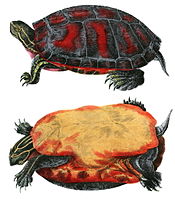Clemmys: Difference between revisions
No edit summary |
Rescuing 1 sources and tagging 0 as dead. #IABot (v1.5beta) |
||
| Line 29: | Line 29: | ||
==External links== |
==External links== |
||
*[http://www.tortoise.org/archives/clemmys.html Captive husbandry of the Eastern Clemmys], at [http://www.tortoise.org Tortoise.org] |
*[http://www.tortoise.org/archives/clemmys.html Captive husbandry of the Eastern Clemmys], at [http://www.tortoise.org Tortoise.org] |
||
*[http://cfs.nrcan.gc.ca/subsite/glfc-amphibians/clemmys-insculpta Wood Turtle at Natural Resources Canada] |
*[https://web.archive.org/web/20090421141604/http://cfs.nrcan.gc.ca/subsite/glfc-amphibians/clemmys-insculpta Wood Turtle at Natural Resources Canada] |
||
{{Emydidae}} |
{{Emydidae}} |
||
Revision as of 08:19, 9 August 2017
| Clemmys | |
|---|---|

| |
| Clemmys guttata | |
| Scientific classification | |
| Kingdom: | |
| Phylum: | |
| Class: | |
| Order: | |
| Family: | |
| Genus: | Clemmys Ritgen, 1828
|
| Species | |
Clemmys is a genus of turtle, consisting of one North American species, the spotted turtle (C. guttata).
"Clemmys guangxiensis" is a composite taxon described from specimens of Mauremys mutica and the natural hybrid "Mauremys" × iversoni.[1]
Until recently, the genus Clemmys consisted of four species (bog turtle, spotted turtle, western pond turtle, and the wood turtle). Recent genetic analyses have revealed that the spotted turtle is distinct from the other three species.[2] The bog turtle and the wood turtle were moved to the genus Glyptemys, while the western pond turtle has been renamed Actinemys. This makes the spotted turtle the sole member of the genus Clemmys.[3]
The spotted turtle is declining throughout eastern Northern America due to habitat loss and poaching. From this study, most specifically on the Southeastern population, females had greater shell heights, heavier body masses, and longer plastrons than males.[4]
References
- ^ Parham, James Ford; Simison, W. Brian; Kozak, Kenneth H.; Feldman, Chris R. & Shi, Haitao (2001): New Chinese turtles: endangered or invalid? A reassessment of two species using mitochondrial DNA, allozyme electrophoresis and known-locality specimens. Animal Conservation 4(4): 357–367. HTML abstract Erratum: Animal Conservation 5(1): 86 HTML abstract
- ^ Feldman, C.R. and J.F. Parham. (2002). Molecular phylogenetics of Emydine turtles: taxonomic revision and the evolution of shell kinesis. Molecular Phylogenetics and Evolution 22:388-398.
- ^ Spinks, P.Q. and H.B. Shaffer. (2009). Conflicting Mitochondrial and Nuclear Phylogenies for the Widely Disjunct Emys (Testudines: Emydidae) Species Complex, and What They Tell Us about Biogeography and Hybridization. Systematic Biology 58(1):1-20.
- ^ Litzgus, Jacqueline; Mousseau, Timothy (2004). Demography of A Southern Population of the Spotted Turtle (Clemmys guttata). Southeastern Naturalist 3(3):391-400. [1]

